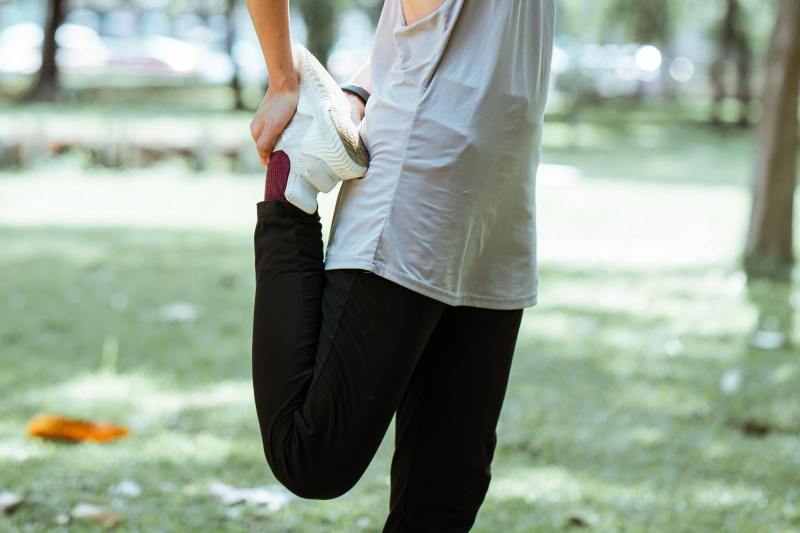
For those who are hoping to tone and build their bodies to their desired appearance, knee pain can seem like one of the biggest hurdles to reaching those goals. In most cases, knee injuries are caused by physical activities, but some people may have chronic knee pain that comes from certain health conditions like osteoarthritis.
The bad news is that no matter what the cause of your knee pain is, it’s very common and easy to develop, even if you’re doing everything correctly. The good news is that there are still ways to catch up with your workout schedule without making the pain worse.

What knee issues can get in the way of exercise?
Knee sprains
Knee sprains occur when the ligaments in and around your knees are stretched too much to the point of tearing. Those experiencing knee sprains may have trouble bending their knees or even walking normally. The pain that can occur from a torn ligament can make certain exercises unbearable if the knees are involved in any form.
While it typically happens due to heavy physical trauma to the knee (i.e., a harsh blow to the area or a car crash), it can easily happen by putting too much pressure on the knees. Some examples of exercises that can place too much stress on the knees include deep squats and lunges if they are not done properly. Running can also be hard on the knees from either the impact of your steps or if you stretch your leg out too far.
Tendonitis
Simply put, tendonitis is the inflammation of tendons attaching the knee muscles to the bones in your leg that allow you to bend. Similar to knee sprains, knee tendinitis can cause pain in your knees when moving or even just bending your knees. Although some cases of tendinitis may require surgery, most cases can be resolved by simply resting.
Again, tendonitis mostly comes from overuse of the knee muscles and ligaments in sports or exercise. Certain exercises that exert pressure on the knees can cause the tendon to weaken and become inflamed, which leads to pain when bending your legs.
Arthritis
Unfortunately, arthritis is not something you can relieve by simply resting your legs; the older you are, the more likely you are to develop it. Arthritis in the knees is known as knee osteoarthritis or degenerative joint disease. This can come from constant use of the knees (especially from physical activity), which leads to progressive loss of articular cartilage and makes it harder to use your knees.
Common symptoms of arthritis in the knee include pain or stiffness in the knees, which can lead to the feeling of your knees “buckling” or otherwise feeling weak. The discomfort that comes from this condition may also affect your ability to walk normally. In some cases, the knee may lock in place with a snapping noise, making it even harder to use that leg properly.

Knee strengthening exercises
Regardless of whatever knee injury you may be experiencing, there are various stretches for knee pain you can do.
Standing quadriceps stretch
This easy exercise helps to improve the flexibility of your quadriceps, which can help alleviate some of the strain on your knees, especially for cyclists and runners. The best part is that you can quickly do these knee stretches anywhere as long as you’re standing.
Instructions:
- Stand on one leg, and keep both of your knees close to each other. You can hold onto something sturdy if you need support.
- Bend the knee of your other leg, bringing your foot closer to your backside. Grab your ankle behind you with the opposite hand.
- Hold this position for about 30 seconds, making sure to breathe deeply.
- Release and slowly lower your leg back to the starting position.
- Repeat the process on the opposite leg.
Leg extensions
Like the quadriceps stretches, leg extensions can be done anywhere as long as you’re sitting. That means that whenever you’re on your break at work, you can support your knees and stretch the muscles.
Instructions:
- Sit upright in a chair with your feet flat on the floor.
- Brace your leg muscles and straighten one leg out in front of you. Make sure that you remain seated at all times when doing this exercise.
- Hold for five seconds, then slowly return the leg to the starting position.
- Repeat on the other leg if desired. Two to three sets of 10 reps should be enough for each leg.
Butterfly flicks
Although butterfly flicks focus primarily on the hips and groin, they can also help ease tension in the muscles around the knees to relieve knee pain and even improve mobility.
Instructions:
- Sit upright on the floor.
- Bend your knees to bring the bottom of your feet together in front of your pelvis, allowing your knees to hover slightly over the floor on both sides.
- Hold your feet together and lean forward at the waist, bringing your head towards the tips of your toes.
- Hold this position for about 30 seconds, making sure to breathe deeply.
- Return to the starting position by slowly straightening your back to sit upright again.
Straight leg raise
This is yet another great stretching exercise that both decreases pain and inflammation in the knee while increasing the range of motion to help with mobility and flexibility.
Instructions:
- Lie on your back. Keep the target leg straight, with the other leg bent, so that your foot is planted firmly against the floor.
- Brace your leg muscles as you slowly raise the straightened leg until the knee is at the same height as the bent one.
- Hold for five seconds, then slowly lower the straight leg back to the starting position.
- Repeat on the other leg if desired. Two to three sets of 10 reps should be enough for each leg.
Side lunges
Although side lunges don’t focus much on alleviating knee pain, they’re still one of the best knee-strengthening exercises to reduce the likelihood of knee pain occurring when working out.
Instructions:
- Stand with your feet together.
- Take a big step to the left with the corresponding leg.
- Move your hips so that your left knee bends and your right knee remains straight. Keep your bent knee in line with your ankle.
- Reverse the movement so you return to the starting position.
- Switch sides and another 10 reps.

Best ways to exercise with knee issues
If you do happen to develop a knee issue, then it may be time to modify your workout routine or even your daily schedule. You mainly want to avoid high-impact exercises or activities that can put too much force on the knee ligaments and joints, such as running or doing deep squats.
You can replace high-intensity workouts and activities with the exercises for knee pain listed above. For more diversity in your routine, consider some of the following alternatives that place less stress on the knees:
- Cycling
- Swimming
- Yoga
- Rowing machine exercises
- Power walking
- Elliptical training
- Resistance training (namely, exercises that focus on toning the arms instead of the legs)
- Pilates
- Tai Chi
If you experience severe knee pain, it is important to talk to your doctor before trying any of the above exercises.

How to support your knees during exercise
Maintain proper form/technique
Even the simplest of exercises can be hard on your knees if you’re not practicing proper form. Knee-centric exercises improperly can place excessive stress on your knees, which can lead to them being strained or torn and thus causing pain in the area. If you can’t seem to maintain proper form for a certain exercise, then find a more manageable alternative or work to correct your form and try again afterward.
Avoid straining your legs too much
It’s precisely because of this excess strain that you may be experiencing knee pain. Never push yourself to do leg exercises if your legs themselves are too tired to even do them. Give them some time to rest in between workout sessions to repair themselves and reduce the overall strain on your knees.
Don’t just focus on your legs
While it’s okay to put a little more focus on your leg muscles, that doesn’t mean you should neglect the rest of your body. Even if you want to target certain muscles, creating a total body workout routine is essential for preventing injury while promoting overall health.
Editors' Recommendations
- What is hot yoga? Why this should become your new winter workout
- 11 killer 10-minute workouts to transform your fitness routine
- The benefits of yoga: Why you need to add it to your workout routine today
- Experts reveal why you have upper back pain (and what you can do about it)
- 12 fantastic reasons to add jumping jacks to your workout routine




